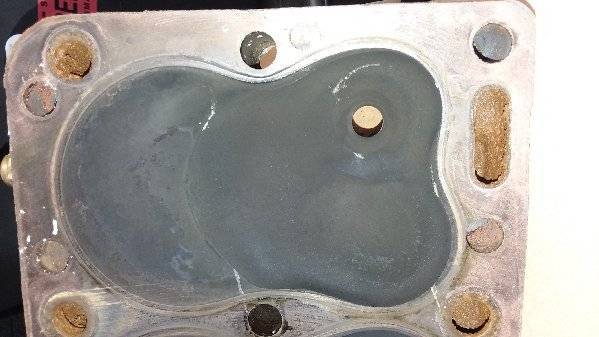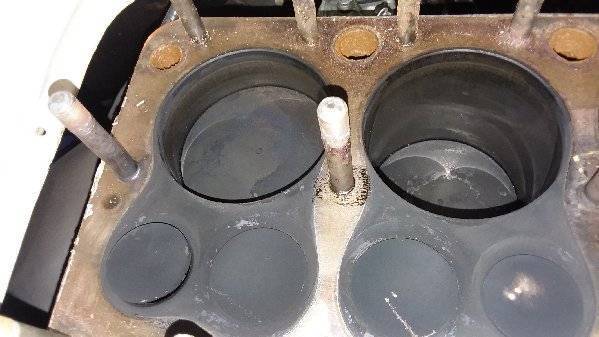|
Re: tracking down ticking noise
|
||||
|---|---|---|---|---|
|
Forum Ambassador

|
Your thinking about the gap is applicable to mechanical lifters, but not hydraulics.
The use of the tool and the specification for the gap is only to maintain the gap within the ability of the lifter to accommodate. When the engine is running, there is no "gap" between the lifter and the valve stem - the function of the hydraulic lifter is to extend and eliminate the gap. And when the engine gets warm the valve stem expands (lengthens), thus in your case allowing the valve head to touch the cylinder head, or at least that's my guess. Why it didn't occur before is a good question, were the valves reinstalled in the same positions they were removed from?
Posted on: 2019/5/8 7:43
|
|||
|
||||
|
Re: tracking down ticking noise
|
||||
|---|---|---|---|---|
|
Home away from home
|
Good Morning all...Owen/Dave do you think that the current head gasket could be a little bit less thick than the old one? Ernie in Arizona
Posted on: 2019/5/8 9:22
|
|||
|
Caretaker of the 1949-288 Deluxe Touring Sedan
'Miss Prudence' and the 1931 Model A Ford Tudor 'Miss Princess' 
|
||||
|
||||
|
Re: tracking down ticking noise
|
||||
|---|---|---|---|---|
|
Home away from home
|
This is supposed to check the "take-up reserve" on each of the hydraulic lifters, which is what you are referring to. I did not originally do this because I didn't have the tool and i did not change any valves or reseat any of them. I did number the valves as they came out, so I am pretty certain they all went back in their original positions.
When I started getting this ticking, it is one of the things I considered could be an issue, so I got the tool in order to check it. But, as noted, I seem to have plenty of clearance at the offending valve. I do assume if the gap is too small, then it could result in the valve extending too far into the cylinder and hitting the head. I wonder if the hydraulic itself is not collapsing to the extent required during the cycle. I will change out this hydraulic in any case. I don't see any way to actually check the tolerances with the hydraulic lifter in place. It looks to me like the head gaskets are identicle. I hung to old one on a peg when i originally pulled apart the engine, so i will check the thickness when i am in my garage next, but I think they are the same.
Posted on: 2019/5/8 13:00
|
|||
|
1941 Touring Sedan
1952 250 Convertible 1932 902 Rumble seat Coupe  Who is John Galt? Who is John Galt?
|
||||
|
||||
|
Re: tracking down ticking noise
|
||||
|---|---|---|---|---|
|
Forum Ambassador
|
If the valve spring has lost some tension that might let a lifter extend more than it normally would so that a valve might hit. Valve spring height and strength is one of the things suggested to check during valve jobs so that issue must have come up before. As you said, a defective lifter could possibly not be draining off the prescribed amount and instead keeps "pumping up". If the oil pressure is higher than expected that might also affect a lifter -- particularly if it is marginal -- although I would expect more than one might act up if that were the case.
Posted on: 2019/5/8 13:19
|
|||
|
Howard
|
||||
|
||||
|
Re: tracking down ticking noise
|
||||
|---|---|---|---|---|
|
Home away from home
|
I need to replace one exhaust valve before I put this back together. Since I am using all the other original valves in the original holes, i'll just lap the one new one.
I had the valve springs tested and they are all good. The head checked and it is good. I did not have it surfaced. Last time around, I retorqued this several times, and it always seemed to need it. Head gasket is from Merritt, and I think it is copper clad. I have always waited for an engine to cool before retorquing, which I think is correct for cast. I will immediately retorque after i first start it and let it get up to temperature. After that, how many times should I need to retorque the head?
Posted on: 2019/5/22 12:35
|
|||
|
1941 Touring Sedan
1952 250 Convertible 1932 902 Rumble seat Coupe  Who is John Galt? Who is John Galt?
|
||||
|
||||
|
Re: tracking down ticking noise
|
||||
|---|---|---|---|---|
|
Home away from home
|
I am putting this back together now. When I did this last time, I replaced the hydralic lifters, so they were new and went in dry. Should I flush out the lifters with kerosine before I put them back in, or are they OK to go in with oil in them?
Posted on: 2019/6/6 13:23
|
|||
|
1941 Touring Sedan
1952 250 Convertible 1932 902 Rumble seat Coupe  Who is John Galt? Who is John Galt?
|
||||
|
||||
|
Re: tracking down ticking noise
|
||||
|---|---|---|---|---|
|
Forum Ambassador

|
You probably should retorque the head at least 3 times, or until it no longer takes any further tightening. First retorque after perhaps a hour of running. 2nd after perhaps 10-20 hours. 3rd at the end of the season. Or at least that's been my practice for years.
I'd install lifters lubed with clean motor oil. And some oil in the cylinder block lifter bore and perhaps an assembly lube on the face of the tappet body where it contacts the camshaft, if disassembly went that far. And don't forget to check the clearance to the stem.
Posted on: 2019/6/6 14:27
|
|||
|
||||
|
Re: tracking down ticking noise
|
||||
|---|---|---|---|---|
|
Home away from home

|
There is a limit as to how much those cylinder heads can be milled. It may be a different head than original as well.
If all that is desired is to stop the valve from hitting the head the valve head can be cut back (chamfered). This is used to increase flow as well. Although Packard manuals specify torque for dry threads, the modern practice is for lubricated threads given clamping force is increased 40%. However, some of those old motors start to yield and lose clamping force. Pierce-Arrows are good for that. The tendency of those low compression motors to blow through head gaskets when they get old is an engineering problem the first step of which is to determine the operating pressures inside the cylinder. My suspicion is those thick gaskets don't work, given modern cars use essentially a spacer package and run much higher compression ratios. An example using anti-seize provides a good example. We do a lot of lab testing for EPA purposes. Some of these cars have exhaust studs in difficult places and I've seen some big guys struggle. I had one of these that called for a torque of 45 NM dry. I put anti-seize of the studs and torqued it to 30 NM to account for the anti-seize. Well they blew the engine running it at 10,000 rpm with a supercharger on it. When it came back the fella said "Gee these exhaust bolts aren't even tight." I told him that is because I put anti-seize on them which increases the clamping force and showed him the gaskets which showed no indication of leakage under those extreme conditions.
Posted on: 2019/6/6 19:42
|
|||
|
||||
|
Re: tracking down ticking noise
|
||||
|---|---|---|---|---|
|
Home away from home
|
Put everything back together. For the first wonderful half hour or so, the motor sounded great. But after driving it at about 55 for about half an hour, the dreaded noise is back, louder than ever it seems. At this point I have pretty much ruled out top end.
I can hear the noise the loudest with my stethescope directly on the passenger side cylinder head bolts directly between no. four and five cylinders. Directly on the head it is quieter. Pulling plug wires individually does not affect the noise. Seems to be getting louder over time. I think next I'll plasigage the rods, then the mains. Generally, again with my scope, the sound is much less underneath the car on a lift then up top, but sound can travel through the engine in all kinds of funny ways. Really can't find it much from underneath. One thing I do note though, from underneath, the sound (whether a tick or a knock) is most distinguishable with my scope directly on the passenger side motor mount, and also directly on the oil pump bolts. Both areas transmit through the scope quite loudly and clearly. I did replace the oil pump gasket last time I did this exercise with a regular gasket. I see some of the guys on the forum say to use very thin paper. I get a constant 30 lbs (but spec is 40) at idle as well as under acceleration. I do wonder if there is anything in the oil pump (or my installation) that could cause a ticking or knocking noise. I assume this is probably just sound traveling, but I did pull the pump last time before this noise became more noticable. Would have bet this was top end, but I am running out of possibilities. Any thoughts or suggestions are appreciated.
Posted on: 2019/6/20 1:37
|
|||
|
1941 Touring Sedan
1952 250 Convertible 1932 902 Rumble seat Coupe  Who is John Galt? Who is John Galt?
|
||||
|
||||

 (108.92 KB)
(108.92 KB)









